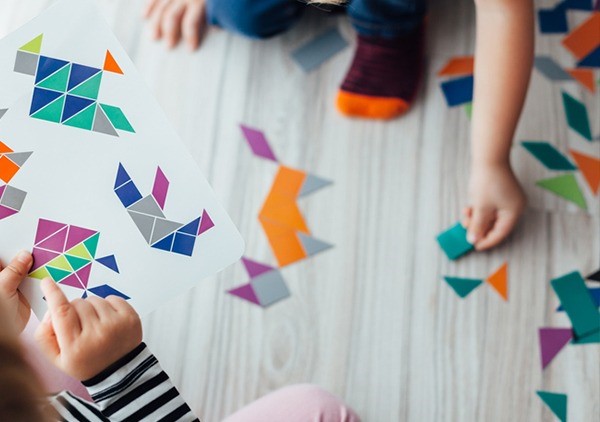- 855.224.8655
- Schedule a Tour

Math is an important component of early childhood education. In fact, it may even be a better indicator of future academic success than other learning areas. Math is a part of your child’s daily life; it’s just a matter of helping them develop those important skills.
Math manipulatives are a great way to make math fun and engaging! Manipulatives connect abstract concepts to real-world objects. Learn how manipulatives can help to reinforce preschool math concepts your child is learning in the classroom.
Preschool Math Concepts
Your child is learning to count, add or subtract, sort, and measure at this age. These are some of the math skills preschoolers are developing.
- Counting sets of objects
- Counting from 1-10
- Identify written numerals
- Understanding concepts like quantity (“more” and “less”)
- Adding and subtracting small quantities (putting together or taking away)
- Putting written numbers in order
As your child nears kindergarten, his or her math skills should progress. For example, he or she may be able to count larger sets of objects and verbally count above 10 as development continues. Your child will also be able to correctly use concepts like “more” or “less” or “smaller” or “larger” in their vocabulary.
These math skills are a great foundation for other STEAM concepts including engineering, science, and technology.
Math Manipulatives
One of the best ways to work with your child on mathematical concepts is to use hands-on materials or manipulatives. When he or she can touch and move manipulatives or real objects while learning, it creates a sensory experience that’s much more engaging. Use concrete materials with him or her to develop a conceptual understanding before learning abstract concepts.
Here are a few math manipulatives for preschoolers that you can practice with at home.
Unifix Cubes
These cubes connect on all six sides and can be placed together. As your child works on patterning, counting, sorting by color, and operation skills, the square cubes build fine motor skills and eye-hand coordination too.
The Unifix Cubes also come with an activity booklet. You may get more ideas from your child’s preschool curriculum, or you can keep the activities open-ended!
One-Inch Blocks
These hardwood cubes are perfect for beginning counting, patterning, and color recognition. They’re also great for teaching basic geometric concepts. They are also good for beginning measurement activities. You can ask your child how many one-inch blocks are as long as the side of a book or another object.
You can also use them to introduce your child to engineering concepts. Use them to build different structures. How tall can your child make the structure before the blocks fall down? What happens when you take away a block? Engineering and math are closely tied together. Use these blocks to increase your child’s confidence in both learning areas.
Pattern Blocks
These blocks are versatile manipulatives with more than one purpose. They come in six colors and shapes and can be used to teach everything from number sense to graphing, patterning, and more.
Keep these pattern blocks through elementary school! Your child can continue to use them to learn geometry and other advanced math concepts. The manufacturer designed these to work for children up to eighth grade.
You don’t have to purchase math manipulatives for your child to learn! Household items like plastic bottle caps, old keys, and buttons provide excellent hands-on learning opportunities.
Manipulatives can equip your child with a strong set of math skills that they can build upon for kindergarten. Learn about other kindergarten-readiness skills your preschooler should be mastering.
